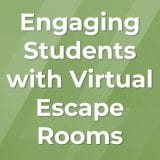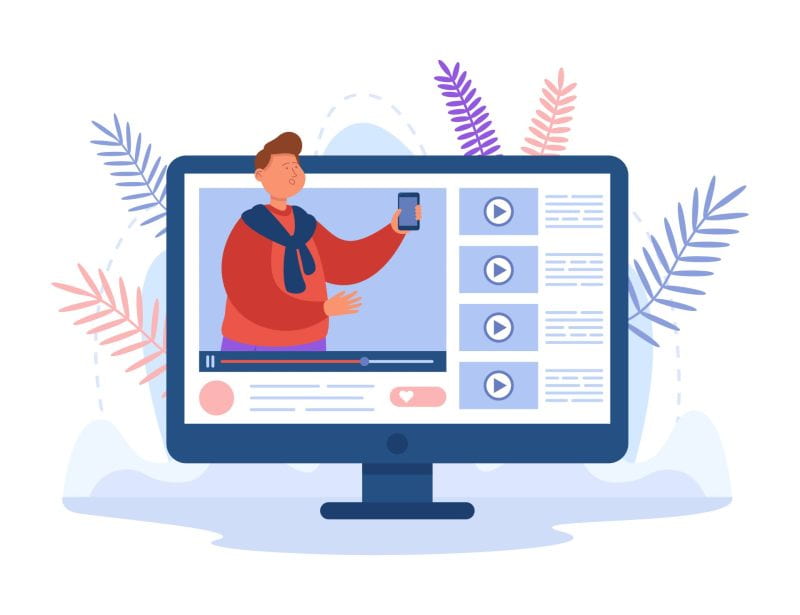LEC Articles: Year in Review 2023

Engaging Students with Virtual Escape Rooms
 Virtual escape rooms have become quite popular in higher education. They’ve been used in education, business, healthcare, and many other disciplines. In general, as defined in the education context, a virtual escape room is a computer-based problem-solving activity that uses puzzle rooms and game-like components to educate and engage learners. Escape rooms are an excellent way to engage students by gamifying your lessons and making them fun to learn, while reinforcing existing knowledge. In this article, we discuss the process of planning and developing your own escape room.
Virtual escape rooms have become quite popular in higher education. They’ve been used in education, business, healthcare, and many other disciplines. In general, as defined in the education context, a virtual escape room is a computer-based problem-solving activity that uses puzzle rooms and game-like components to educate and engage learners. Escape rooms are an excellent way to engage students by gamifying your lessons and making them fun to learn, while reinforcing existing knowledge. In this article, we discuss the process of planning and developing your own escape room.
Increasing Student Engagement and Communication Using Emojis and Memes
 Emojis and memes are pervasive in modern communication and have even made their way into commercial advertisements. However, we as educators can use their informal nature to our advantage. Emojis and memes can be used as Icebreakers, a tool to demonstrate concepts, a visual way-finder, and a means to promote readability and accessibility.
Emojis and memes are pervasive in modern communication and have even made their way into commercial advertisements. However, we as educators can use their informal nature to our advantage. Emojis and memes can be used as Icebreakers, a tool to demonstrate concepts, a visual way-finder, and a means to promote readability and accessibility.
The Role of Formative Assessment in Student-Centered Teaching
 As educators, we want students to be successful. So how do we define “success”? At the most basic level, it would be accomplishing a course’s stated learning objectives and getting a good grade — eventually doing that enough times to graduate and get a degree. But how many instructors and students feel engaged and motivated by that? And what kind of learning-awareness and real-world skills does that develop in our students?
As educators, we want students to be successful. So how do we define “success”? At the most basic level, it would be accomplishing a course’s stated learning objectives and getting a good grade — eventually doing that enough times to graduate and get a degree. But how many instructors and students feel engaged and motivated by that? And what kind of learning-awareness and real-world skills does that develop in our students?
LEC Instructional Designer Wins iSpring Championship Contest
 Jihong Tang, one of our excellent Instructional Designers entered a contest hosted by the eLearning software developer iSpring Solutions. The competition sought to have designers create an eLearning activity that utilized some features of the software while incorporating interaction and engaging users.
Jihong Tang, one of our excellent Instructional Designers entered a contest hosted by the eLearning software developer iSpring Solutions. The competition sought to have designers create an eLearning activity that utilized some features of the software while incorporating interaction and engaging users.
Bite-Sized Learning
 Our digitally connected world may be changing how people learn along with their need to retain information. Since technology makes it easy to stay connected, it is becoming increasingly difficult to function without accessing the Internet for tasks like checking emails, social networking, settling arguments, shopping, and almost every day-to-day activity. The internet has also increasingly become a place where people go to learn. The increasing desire to be socially connected and have an awareness of the world around us creates constraints on our time which have encouraged the growth of microlearning. Technology has made it simpler to offer and access small pieces of educational content through a well-known instructional design technique known as chunking (Gobet, 2005). Because of this shift, microlearning has become appealing in some learning environments.
Our digitally connected world may be changing how people learn along with their need to retain information. Since technology makes it easy to stay connected, it is becoming increasingly difficult to function without accessing the Internet for tasks like checking emails, social networking, settling arguments, shopping, and almost every day-to-day activity. The internet has also increasingly become a place where people go to learn. The increasing desire to be socially connected and have an awareness of the world around us creates constraints on our time which have encouraged the growth of microlearning. Technology has made it simpler to offer and access small pieces of educational content through a well-known instructional design technique known as chunking (Gobet, 2005). Because of this shift, microlearning has become appealing in some learning environments.
Canvas Corner: Bulk Publishing and Submit on Behalf of a Student
 Canvas has been recently updated with some new features that may be helpful to instructors. These updates include the ability to bulk publish or unpublish modules in a course, and the ability to submit assignments on behalf of a student. Instructors can now bulk publish all modules or individual modules, as well as unpublish them in bulk. This provides instructors with more options and improves efficiency when publishing modules. You now have the option to publish all modules and items or all modules only, along with the option to unpublish all modules and items.
Canvas has been recently updated with some new features that may be helpful to instructors. These updates include the ability to bulk publish or unpublish modules in a course, and the ability to submit assignments on behalf of a student. Instructors can now bulk publish all modules or individual modules, as well as unpublish them in bulk. This provides instructors with more options and improves efficiency when publishing modules. You now have the option to publish all modules and items or all modules only, along with the option to unpublish all modules and items.
Choosing Appropriate Instructional Content for a Course
 Choosing appropriate instructional content for a course can be a complex and time-consuming task. For many subject areas, there are far more potential instructional materials that could, or should, be part of what a course will include. Because we recognize this challenge, we are providing some useful tips that can help to narrow down and select the appropriate instructional materials for any course.
Choosing appropriate instructional content for a course can be a complex and time-consuming task. For many subject areas, there are far more potential instructional materials that could, or should, be part of what a course will include. Because we recognize this challenge, we are providing some useful tips that can help to narrow down and select the appropriate instructional materials for any course.
Maximizing Student Engagement and Learning with NSU Video Tools
 Educational videos have become an important content-delivery tool in higher education. Video learning can be a great supplement to traditional learning methods in higher education. Passive engagement with videos is insufficient for learning. In this article we share several tools that you can use to create more active engagement with your video content that are available from NSU.
Educational videos have become an important content-delivery tool in higher education. Video learning can be a great supplement to traditional learning methods in higher education. Passive engagement with videos is insufficient for learning. In this article we share several tools that you can use to create more active engagement with your video content that are available from NSU.
Harnessing generative AI tools for Assignments, Activities, and Assessments
 Now that generative AI (gAI) has become available to the wider public, there has been a lot of discussion about the implications of these tools on the world of higher education. One of the interesting areas for exploration is the ability to leverage the use gAI for coursework such as assignments, activities, and assessments. Ideas are continually emerging, and the possibilities seem endless. This article provides a few examples and starts to answer the question of how can gAI be used as both a student tool for learning and a faculty tool for designing learning.
Now that generative AI (gAI) has become available to the wider public, there has been a lot of discussion about the implications of these tools on the world of higher education. One of the interesting areas for exploration is the ability to leverage the use gAI for coursework such as assignments, activities, and assessments. Ideas are continually emerging, and the possibilities seem endless. This article provides a few examples and starts to answer the question of how can gAI be used as both a student tool for learning and a faculty tool for designing learning.
Artificial Intelligence is Here
 Every day new Artificial Intelligence (AI) stories are in the news, on social media, and in your email promoting new “AI-driven” products. With the introduction of ChatGPT, Microsoft Bing, and Google Bard, more than likely, you have been unable to avoid hearing about AI, but do you really know what it is? How will generative AI affect education, your job, your life?
Every day new Artificial Intelligence (AI) stories are in the news, on social media, and in your email promoting new “AI-driven” products. With the introduction of ChatGPT, Microsoft Bing, and Google Bard, more than likely, you have been unable to avoid hearing about AI, but do you really know what it is? How will generative AI affect education, your job, your life?
Learning with the LEC
Learning with the LEC: Using Polls to Create Breakout Rooms in Zoom
This Learning with LEC video shares another new tip with you – creating breakout rooms based on the poll results in Zoom. This new feature of Zoom helps you create more engaging and customized breakout sessions for your participants.
Learning with the LEC: Using the Accessibility Checker in Canvas
Accessibility means designing content that is accessible to people with a diverse range of hearing, movement, sight, or cognitive abilities. It means making sure all users can access your content as easily as possible. Accessibility is a crucial component to course content that is often overlooked, and Canvas’ Accessibility Checker is here to help.
In this video tutorial, you will learn how to use the Accessibility Checker in Canvas to identify accessibility issues and provide you with solutions to make your content accessible and easier to navigate for all users.
Learning with the LEC: Create Appointment Slots through Canvas Calendar
In this video tutorial, you will learn how to create and edit appointment slots through the Canvas calendar. This is a great way to set up individual or group appointments, allowing students to reserve the appointment slot they wish, with the information showing up in both their, and your, calendars. Students will be reminded of the appointment in their “To Do” column on their dashboard.
Learning with the LEC: Creating and Managing Assignments through the Canvas Calendar
Did you know that you can create and manage assignments for your courses through the Canvas calendar? The calendar allows you to see assignments from all your courses in one central place. You can create new assignments or change assignment details directly from the calendar. You can easily change due dates, for example, by just dragging the assignment to a different date. This quick video tutorial will guide you through the steps.
Learning with the LEC: Hide and Manage Navigation Links in Canvas
Navigation links are an important part of the student experience in the Canvas LMS. Navigation should be clear and simple for students, and they should only see the links you want students to have access to. The order of navigation links can be changed, and links can also be hidden so links won’t appear in your students’ navigation panel. This will simplify navigation and remove the distraction of unneeded links. This video tutorial will guide you on how to manage and hide navigation links for students.
